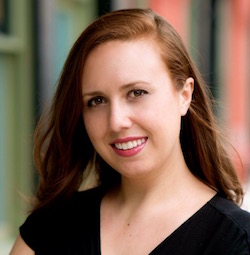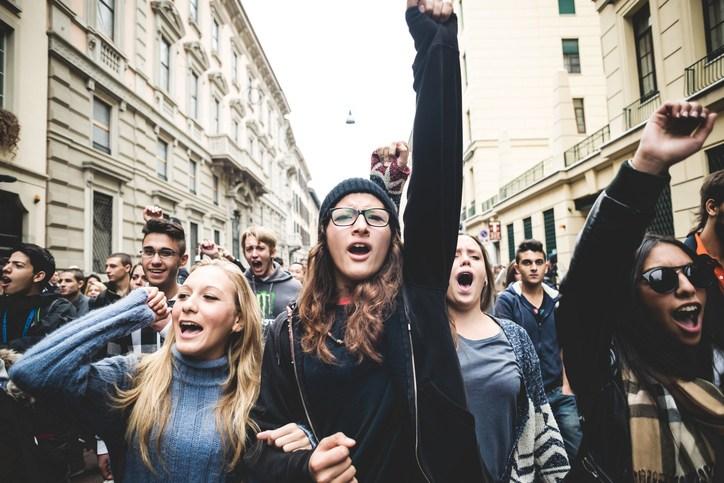- Our School
- Our Advantage
- Admission
- Elementary•Middle School
- High School
- Summer
- Giving
- Parent Resources
- For Educators
- Alumni
« Back
The Voices of Students Like Me
August 16th, 2017

When you think about social movements that you learned about growing up, what do you remember? What do you see in your mind’s eye? For a moment, reflect on your experience when you learned about the civil rights movement. Were you sitting at your desk in a darkened history classroom, watching Dr. King deliver his "I Have a Dream" speech? Were you at a museum, perusing photographs and listening to an audio tour about marches and demonstrations?
"Individuals with learning and attention issues need the opportunity to join together, share their experiences, serve as leaders, models, and mentors, and articulate a vision for a different future that we can all embrace."
How about the women’s rights movement? Do images of Susan B. Anthony, Elizabeth Cady Stanton, or Margaret Sanger come to mind? When you think about the disability rights movement, are you reminded of people crawling up the steps of the Capitol Building in Washington D.C., or of parades of able-minded citizens in wheelchairs who were shut out of libraries, museums, and office buildings that lacked curb cuts and ramps? Now… close your eyes and think about the community of individuals with learning disabilities. What do you see?
Organizations have been fighting on behalf of individuals with disabilities, including learning disabilities, for more than 40 years. Yes, the protections of the Individuals with Disabilities Education Act (IDEA) and the Americans with Disabilities Act (ADA) were put in place, and accommodations for those with learning and attentions issues have increased. Public perceptions have started to change, and we’ve seen improvements in high school and college graduation rates. However, I can’t help but ask myself, what is missing?
A Community Lacking a Movement
I was identified with a learning disability in first grade. Neither I, nor my parents, identified with the disability rights movement from the history books and documentaries produced. There was no community with which we could identify, no protest my family could take me to, no leader with similar experiences for me to look up to, no footage to watch about my community, no speeches to inspire me… nothing… just me and my parents sitting with a specialist, my newly minted documentation, and a box of tissues.
Alone and “disabled.”
I was asked to leave my first school. My parents were told: “This is not the right place for Natalie; we are unable to meet her needs here.” Removed from my friends and the school experience I learned to expect, I moved from one school to another, every three years, in search of an educational roadmap that didn’t yet exist for “my kind of learner.”
Throughout my educational journey I found others like me, learned how I learned best, became increasingly resilient and an effective self-advocate, enjoyed academic success, and volunteered for organizations that worked to improve the experience for students like me.
When it was time for me to choose a career path, I struggled. On the one hand, I wanted to enter the workforce as a successful student who happened to be dyslexic, and leave the dream of lending my voice to the disability rights movement behind. It was appealing to think about contributing to society and leading the “normal life” that I so desperately wanted, not letting my label or educational experiences dictate my career path.
On the other hand, there was no denying that the labels “disabled” and “dyslexic” had become a part of who I was, whether I liked it or not. I searched the landscape of organizations that fought for the rights of people with learning and attention issues, and realized that while all were fighting the good fight, not many of my peers with learning disabilities were leading the way.
Then I closed my eyes and remembered the social movements of the past, and realized what was missing and how I could fill that void. It was the voice of students like me who have lived the experience of learning differently. We, who were told, “you can’t,” “you won’t,” “you shouldn’t,” who were held back, graduated late, took tests in closets, transferred schools, dropped out of school, sat at the back of the classroom sweating, sat in the front of the classroom determined, stayed up all night trying, cried on our way to and from school, got that first A, read that first book on our own, told that first friend about the struggle. Those personal and emotion-filled experiences matter and make up an essential pillar of any successful social movement.
Disability Rights Movement on the Rise
At the start of any movement, there is a sense of urgency and unrest, and a core of individuals band together to right a wrong, correct an injustice, or implement changes that help to shape a just, equitable, and inclusive society. Powered by parents and shaped by lawmakers, the disability rights movement put policies and protections in place to ensure that every person with any disability was a valued and contributing member of his or her community.
I started on a journey to join a movement and represented a new generation of my community. I went to graduate school and did research so that I could talk the talk; I already knew how to walk the walk. I now work for the National Center for Learning Disabilities (NCLD), one of the organizations that have been at the forefront of the disability rights movement representing people like me. Because of their work and the collaborative efforts of a handful of other remarkable organizations, individuals with learning disabilities now have real opportunities to develop advocacy skills, build self-confidence, and access the tools needed to succeed in a society that often overlooks the potential of individuals who learn differently.
I am now a proud member of the first wave of young adults who have benefited from these protections. And through this foundation, we have been able to find and develop a voice. I know that NCLD and other organizations working on behalf of people like me understand the power of student voices, but understanding how to incorporate our voices and stories and to utilize them to energize, personalize, and realize the movement, is a much more complicated task.
Even now, I think about that moment with my parents, the newly minted documentation, and the box of tissues and ask, “What could we do now as an organization, as a growing and outspoken community within the larger disabilities rights movement, to lift up and empower our voice? How do we replace the tissues with a soapbox and a megaphone, and how can we prevent shame and stigma from entering our storyline? How can we provide every 10-year-old, 13-year-old, 16-year-old, 18-year-old, 26-year-old like me with a platform, a place in this movement, and a sense of belonging, strength, and purpose?”
Yes, we need laws and regulations, but when we recall the social movements of the past, what do we see? We see the real voices, names, and faces of individuals who are living the experience. Individuals with learning and attention issues need the opportunity to join together, share their experiences, serve as leaders, models and mentors, and articulate a vision for a different future that we can all embrace.
As a young professional, every year that goes by distances me from the day-to-day student experience, and I have a deeper appreciation of the importance of integrating the voices of students even more now. I am proud to work for NCLD, an organization that is committed to integrating and lifting up student voices. NCLD is committed to ensuring that all programming is informed and guided by the very population we serve. In addition to our Student Voices Research and internship program, we have engaged young adult advisors, and incorporated their voices and perspectives in our strategic plan. These steps are just the beginning. I encourage all organizations currently working to defend and protect the rights of a population that is not yet fully integrated into the organization, to find a way to include the voices of those served. Consider asking yourself the question: “Who is the face of our mission?” And if that face isn’t sitting at the desk next to you, then we have work to do.
When I have children, my hope is that they will close their eyes, think about the disability rights movement, see my face, and the many faces of individuals with learning disabilities among a crowd of many.
This post was originally published on New Profit's website.
About the Author

Natalie Tamburello is on the Learning Resources & Research team at the National Center for Learning Disabilities.
Posted in the category Learning Disabilities.






















